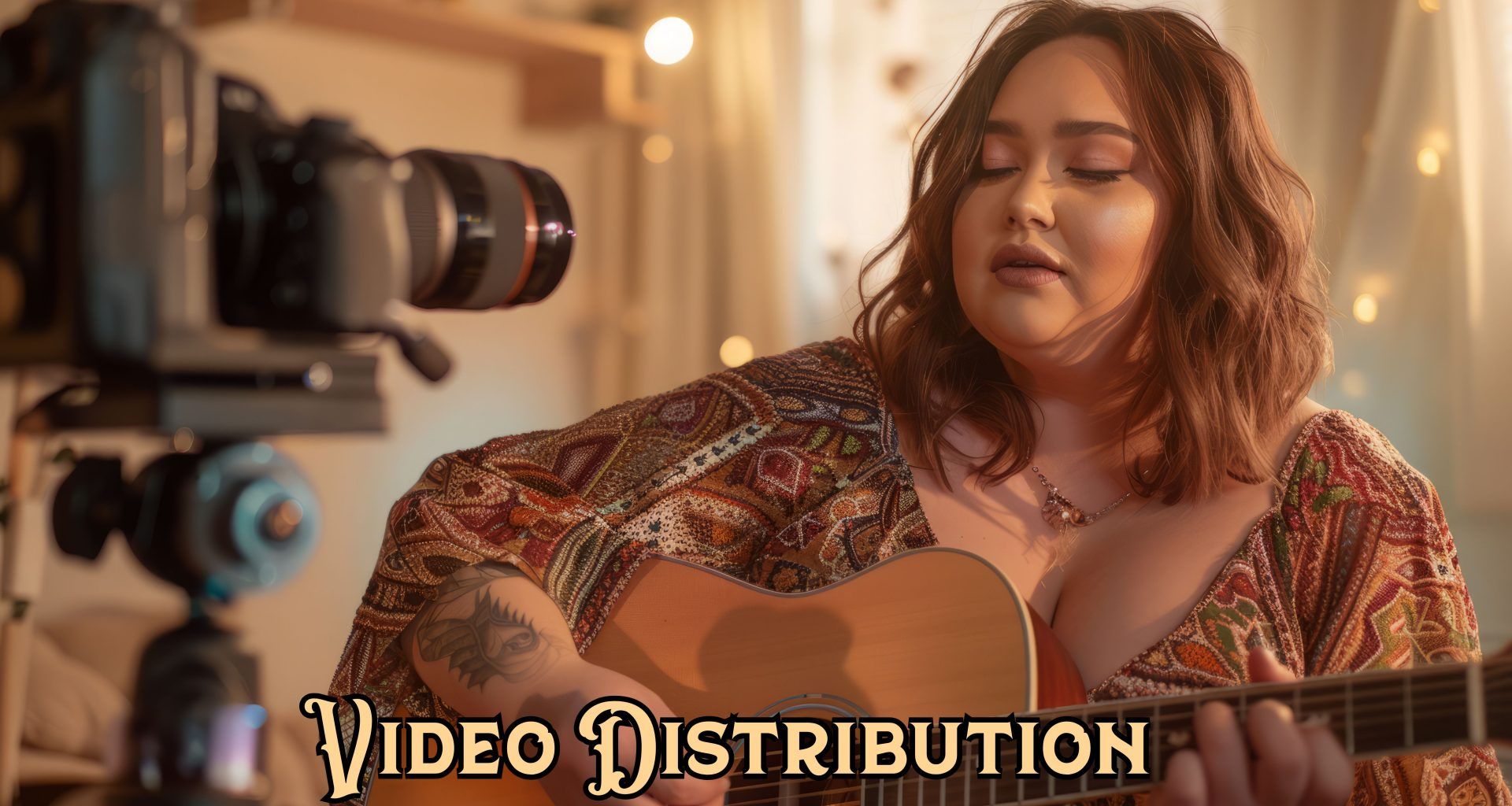In today’s digital landscape, video distribution is crucial for artists aiming to expand their reach and connect with a global audience. Whether you’re an independent musician, a visual artist, or a band, distributing your video content effectively can be the key to your success. This comprehensive guide explores the significance of video distribution, the best platforms to utilize, and strategies to maximize the impact of your videos.
Why Video Distribution is Essential
1. Engaging Content
Videos are among the most engaging types of content available today. They allow artists to convey emotions, tell stories, and communicate messages in a dynamic and captivating manner. For artists, this means a unique opportunity to showcase their work and personality, fostering a deeper connection with their audience. Whether it’s a music video, a behind-the-scenes look, or a creative visual piece, videos provide a versatile medium for artistic expression.
2. Expanding Reach
One of the primary benefits of effective video distribution is the potential to reach a wider audience. By distributing your content across multiple platforms, you can tap into diverse viewership bases. This not only helps in gaining new fans but also enhances your visibility, leading to more opportunities such as collaborations, live performances, and sponsorship deals. The global nature of the internet means your content can be seen by people from all corners of the world, further broadening your reach.
3. Revenue Generation
Videos are not just a tool for engagement; they can also be a significant source of income. Platforms like YouTube and Facebook allow creators to monetize their content through ads, sponsored content, and even direct sales. For artists, this can mean a steady stream of revenue that supports their creative endeavors. Understanding and leveraging these monetization options is essential for maximizing the financial potential of your video content.
Top Platforms for Video Distribution
Choosing the right platforms is a critical step in the video distribution process. Each platform has its own strengths and audience demographics, making it essential to select those that align with your goals and target audience.
1. YouTube
As the world’s largest video-sharing platform, YouTube is an indispensable tool for artists. It boasts over 2 billion monthly logged-in users and offers a plethora of features tailored to creators. Artists can create channels, organize videos into playlists, and interact with viewers through comments and live streams. YouTube’s monetization options, including ads, memberships, and Super Chats, provide multiple revenue streams for artists.
Key Features:
- Global audience reach
- Diverse monetization options
- Detailed analytics and insights
- Integration with Google services
2. Vimeo
Vimeo is known for its high-quality video hosting and professional community. It’s a preferred platform for filmmakers, artists, and creative professionals who prioritize video quality and customization. Vimeo offers several membership plans, including free and premium options, each providing access to various tools and features like custom video players, privacy controls, and advanced analytics.
Key Features:
- High-quality video hosting
- Ad-free experience
- Customizable video player
- Robust privacy options
3. Instagram and IGTV
Instagram has evolved from a photo-sharing app to a versatile platform supporting various content types, including videos. IGTV allows for longer videos, making it ideal for artists to share more in-depth content, such as performances or tutorials. Additionally, Instagram Stories and Reels provide opportunities for short, engaging videos that can quickly capture viewers’ attention.
Key Features:
- Integration with Instagram’s social ecosystem
- Short and long-form video support
- Real-time engagement through comments and direct messages
- Highly visual and interactive format
4. Apple Music
Apple Music is not just a streaming service but also a platform for video content, particularly music videos, live performances, and exclusive artist interviews. Artists can use Apple Music to reach a dedicated music audience and take advantage of the platform’s high-quality video capabilities. The addition of features like Apple Music TV further expands the potential for video content distribution.
Key Features:
- Integration with a premium music streaming service
- High-quality video content
- Exclusive access to artist interviews and live performances
- Monetization through exclusive content and streams
5. Facebook and Facebook Watch
Facebook continues to be a significant platform for video content, with features like live streaming, Watch Parties, and the dedicated Facebook Watch section. It allows for longer video formats, making it suitable for series, vlogs, and detailed tutorials. Facebook’s robust social features enable artists to build a community and engage directly with their fans.
Key Features:
- Integration with Facebook’s extensive social features
- Options for video monetization
- Live streaming capabilities
- Community-building tools
Effective Strategies for Video Distribution
Successful video distribution requires more than just uploading your content. Here are some key strategies to ensure your videos get the visibility they deserve:
1. Optimize Your Content
To make your videos as accessible and appealing as possible, optimize them for each platform. This includes choosing the right video format, aspect ratio, and length. For example, vertical videos work well on Instagram and TikTok, while horizontal videos are more suitable for YouTube and Facebook. Ensuring that your videos are correctly formatted and visually appealing can significantly enhance their performance.
2. Use Engaging Thumbnails and Titles
The thumbnail and title of your video are the first things viewers see. They play a crucial role in whether or not someone decides to watch your video. Use high-quality, eye-catching thumbnails and create compelling titles that accurately represent your content. A good thumbnail and title can increase your video’s click-through rate, drawing more viewers to your content.
3. Leverage SEO and Keywords
SEO is not just for written content; it’s also crucial for videos. Use relevant keywords in your video titles, descriptions, and tags to improve discoverability. Keywords help search engines and platform algorithms understand what your content is about, making it easier for potential viewers to find your videos. For instance, incorporating the focus keyword “video distribution” multiple times in your description and tags can attract viewers interested in this topic.
Promoting your videos across all your social media channels can significantly boost their visibility. Share links, post snippets, and use stories to drive traffic to your videos. Cross-promotion not only increases your video’s reach but also encourages followers from one platform to engage with your content on another. This strategy helps in building a cohesive online presence and maximizes the impact of your content.
5. Engage with Your Audience
Engagement is key to building a loyal fan base. Take the time to respond to comments, ask for feedback, and encourage viewers to like, share, and subscribe. Engaging with your audience not only helps build a community but also boosts your video’s visibility through platform algorithms. The more engagement your video receives, the more likely it is to be recommended to other users.
6. Consistency is Key
Regularly posting content is essential for maintaining and growing your audience. Develop a content calendar and stick to a consistent posting schedule. Whether it’s weekly, bi-weekly, or monthly, consistency helps in keeping your audience engaged and looking forward to your next release. It also signals to platforms’ algorithms that you are an active creator, which can lead to more exposure.
7. Utilize Analytics
Understanding how your videos are performing is crucial for refining your strategy. Use the analytics tools provided by each platform to track metrics like views, watch time, engagement rate, and audience demographics. These insights can help you understand what’s working and what’s not, allowing you to make data-driven decisions. Adjust your content and strategies based on these insights to continually improve your video distribution efforts.
Maximizing Monetization Opportunities
Monetizing your video content can be a significant source of income. Here are various ways to earn revenue through video distribution:
1. Ad Revenue
Platforms like YouTube and Facebook offer revenue-sharing programs where creators can earn money through ads displayed on their videos. The amount you earn depends on the number of views and ad interactions. Joining these programs is an excellent way to monetize your content, especially if you have a substantial number of followers.
2. Sponsored Content
Another way to earn money is through sponsored content. Brands may pay you to feature their products or services in your videos. This can be a lucrative revenue stream, especially if your content aligns well with the brand’s image and audience. However, it’s crucial to disclose sponsored content to maintain transparency with your viewers.
3. Merchandise Sales
Selling merchandise related to your brand can be a profitable venture. You can promote your merchandise in your videos and provide links to your online store. This not only generates revenue but also strengthens your brand identity. Items like T-shirts, posters, and exclusive content can appeal to your most dedicated fans.
4. Crowdfunding and Donations
Platforms like Patreon and Ko-fi allow fans to support you through donations or paid memberships. In exchange, you can offer exclusive content, early access, or other perks. This model is especially effective for creators with a loyal fan base who are willing to pay for extra content and closer interaction.
5. Licensing and Sync Deals
If you’re a musician, consider licensing your music for use in films, TV shows, commercials, and other media. This can be a lucrative source of income, especially if your music is featured in popular productions. Licensing not only generates revenue but also increases exposure to new audiences.
Challenges in Video Distribution and How to Overcome Them
1. Copyright Issues
One of the most significant challenges in video distribution is dealing with copyright issues. Always use original content or obtain the necessary permissions to use copyrighted material. This includes music, images, and video clips. Platforms are stringent about copyright violations, and failing to comply can result in penalties or content removal.
2. Platform-Specific Regulations
Each platform has its own set of rules and guidelines. Familiarize yourself with these to avoid penalties or content removal. For example, YouTube has specific policies regarding content suitable for all audiences, while Instagram has rules about using copyrighted music in Reels and Stories. Adhering to these regulations is crucial for maintaining your account’s good standing.
3. Keeping Up with Trends
The digital landscape is constantly evolving, with new trends and technologies emerging regularly. Stay informed about the latest trends in video content, distribution methods, and audience preferences. This knowledge will help you stay relevant and adapt to changes quickly. Being an early adopter of new trends can also give you a competitive edge and attract a larger audience.
Conclusion
Video distribution is an essential aspect of an artist’s digital strategy. By understanding the different platforms, employing effective strategies, and overcoming challenges, you can maximize your reach and impact. Remember to stay consistent, engage with your audience, and explore various monetization opportunities. With the right approach, video distribution can be a powerful tool in your artistic journey.
For further reading, explore these related articles:
- What Are Deliver My Tune Mastering Services?
- How to Distribute Music on Deliver My Tune
- Boost Your Musical Potential with Deliver My Tune’s Exciting New Services!
For additional resources on music marketing and distribution, visit Deliver My Tune.






